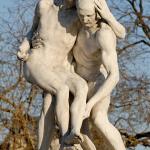Oftentimes, when Jesus went to Jerusalem to worship at the temple during appointed feasts, religious authorities who were jealous of his popularity would question him in an effort to get him to teach against the Law of Moses (Torah) in hopes that they could condemn him for it. One of those times they brought a woman to him whom they had caught in the act of adultery. The account does not say if the woman was married, and this omitted detail is not important to the story. At least one of the guilty parties had to be married for it to be adultery. This account from the NRSV appears only in the Gospel of John, in John 7.53—8.11, as follows:
7 53 [Then each of them went home,
8 1while Jesus went to the Mount of Olives. 2 Early in the morning he came again to the temple. All the people came to him and he sat down and began to teach them. 3 The scribes and the Pharisees brought a woman who had been caught in adultery; and making her stand before all of them, 4 they said to him, “Teacher, this woman was caught in the very act of committing adultery. 5 Now in the law Moses commanded us to stone such women. Now what do you say?” 6 They said this to test him, so that they might have some charge to bring against him. Jesus bent down and wrote with his finger on the ground. 7 When they kept on questioning him, he straightened up and said to them, “Let anyone among you who is without sin be the first to throw a stone at her.” 8 And once again he bent down and wrote on the ground. 9 When they heard it, they went away, one by one, beginning with the elders; and Jesus was left alone with the woman standing before him. 10 Jesus straightened up and said to her, “Woman, where are they? Has no one condemned you?” 11 She said, “No one, sir.” And Jesus said, “Neither do I condemn you. Go your way, and from now on do not sin again.”]
In my blog post, “I Am the Light of the World”—Jesus, I told of substantial internal and external evidence indicating that John 7.53—8.11 originally was not a part of the Gospel of John. That is one reason why most Bible versions place this apparent interpolation in brackets, as here in the NRSV, and/or they have a footnote explaining this. The main reason is that all but one of the ancient, complete, Greek manuscripts of this gospel, Codex Bezae, do not contain it; yet a few have it in the Gospel of Luke. Ancient versions also omit it. The NRSV has a footnote saying, “The most ancient authorities lack 7.53—8.11; other authorities add the passage here or after 7.36 or after 21.25 or after Luke 21.38, with variations of text.”
Among leading Johannine scholars, Raymond E. Brown informs of John 8.1-11 (John I–XII, 335), “There are no comments on this passage by the Greek writers on John of the 1st Christian millennium, and it is only from ca. 900 that it begins to appear in the standard Greek text.” And C. K. Barrett (John, 589) begins his treatment of this text by concluding, “It is certain that this narrative is not an original part of this gospel.”
Greek linguists often claim the style and vocabulary of John 8.1-11 is not Johannine. Yet J. H. Bernard (John, 716) is surely right in saying, “the story of the adulteress seems to be an authentic fragment of early tradition.” Also, the Gospel of John may be more sensible if John 8.12 immediately follows John 7.52. Nevertheless, if it is an interpolation, it greatly reflects Jesus’ ministry and involvement with his interlocutors.
We will examine this intriguing story that has captured the attention and imagination of so many Bible readers by posing some questions about it, and I’ll attempt to answer them. Our main focus will be on the question, What did Jesus write on the ground?
Jesus was a Torah teacher par excellence. The Torah’s moral commandments are known for their brevity. That is why Jews constructed 613 laws that supposedly elaborate what Torah says. Jesus constantly taught the deeper meaning of Torah. In doing so, sometimes he cited one or more of these 613 laws and rendered them an incorrect interpretation of Torah.
That is similar to what Jesus did here regarding the very law these men mentioned about adultery. They were “scribes and Pharisees.” Like Jesus, scribes were Torah experts who regularly made copies of scripture as part of their scribal profession. Pharisees were a sect in Judaism known for its teaching of the scriptures. All of these men likely were married since Judaism emphasized marriage and having children in fulfillment of the antediluvian injunction, “Be fruitful and multiply” (Genesis 1.22).
This law against adultery appears three times in Torah. The Decalogue says simply, “You shall not commit adultery” (Exodus 20.14). But in the other two laws, the penalty for committing adultery is included. One says, “the adulterer and the adulteress shall be put to death” (Leviticus 20.10). The other says, “both of them shall die, the man who lay with the woman as well as the woman” (Deuteronomy 22.22). Just as today, “lay with a woman” is a euphemism for sexual intercourse.
Neither penalty proscribed in these last two laws against adultery provides the means for its execution. But in the last one, the penalty for the next stated infraction about sexuality is to “stone them to death” (Deuteronomy 22.24). Plus, Ezekiel 16.38–40 indicates that the penalty for adultery was stoning. Also, Deuteronomy 22.22 tells the purpose of this law against adultery as well as its penalty. It is “so you shall purge the evil from Israel.”
So much for social theorists who contend that this grave penalty for breaking such laws does not help curb that ill behavior. In contrast, the concept of purging evil from society by punishing law-breakers appears often in Torah. According to Bible prophecy, one of the main features of the end times will be rampant lawlessness (Matthew 24.12; 2 Thessalonians 2.3, 7).
As John 8.1-11 states, the motives of these men who brought the adulteress to Jesus were highly suspect. And it is abhorrently duplicitous that they brought her without bringing the adulterer. Furthermore, they had the audacity to say to Jesus, “This woman was caught in the very act of committing adultery,” and “Moses commanded us to stone such women. Now what do you say?” But the law to which they referred says both transgressors are to be put to death. Their act smacks of male chauvinism if I’ve ever seen it! And knowing Jesus, he is going to expose such crass hypocrisy.
J. D. M. Derrett (“Law in the New Testament: The Woman Taken in Adultery,” New Testament Studies 10/1 (1963) pp. 12–16) says the later Talmud required that witnesses of imminent adultery must warn the two people in advance or the witnesses’ testimony would be invalid on the basis of Exodus 23.1–7. Derrett also suggests this injunction may have existed during Jesus’ time. Since these witnesses obviously failed to do that, this omission exposes their evil motive of desiring the couple to commit adultery in order to take the woman to Jesus to test him.
So, Torah says those caught in the act of adultery are to be put to death by stoning. But who is to press charges? Regarding “any crime or wrongdoing” that requires the death penalty, Moses says, “Only on the evidence of two or three witnesses shall a charge be sustained” (Deuteronomy 19.15). Also, if there is suspicion of the veracity of a witness, that person is to be brought before the priests and judges for them to “make a thorough inquiry. If the witness is a false witness, having testified falsely against another, then you shall do to the false witness just as the false witness had meant to do to the other” (vv. 18–19). Then Moses explains, “The rest shall hear and be afraid, and a crime such as this shall never again be committed among you” (v. 20). The Law of Moses had some very efficient checks and balances.
After the charge is brought, inquiry made, and guilt established, who was to do the stoning? Regarding blasphemers of Yahweh’s Name and Sabbath-breakers, Israel’s whole congregation was to stone them (Leviticus 24.16; Numbers 15.32–35). We read that if anyone “transgresses his [God’s] covenant by going to serve other gods and worshiping them,” the congregation must “stone the man or the woman to death” (Deuteronomy 17.2–3, 5). It adds, “The hands of the witnesses shall be the first raised against the person to execute the death penalty, and afterwards the hands of all the people” (v. 7). So, in capital crimes, which included adultery, the witnesses were to cast the first stones, and then the rest of the congregation were to cast stones as well.
Christians preachers have commonly cited this Pericope de Adulterae as evidence of Jesus’ mercy. Yet, not a few readers about this adulteress have thought that when Jesus said to her, “Neither do I condemn you,” he was being too lenient on her. They add he should have condemned her and thereby upheld the Law of Moses. But that represents a clear misunderstanding of the Mosaic law. We just read that it says those who press such charges must be witnesses of the act of adultery. Jesus certainly was not a witness to it. And he was not an official judge, so that he had no lawful authority to interrogate the veracity of the witnesses and condemn her if their testimony appeared truthful.
How did Jesus write “with his finger on the ground”? Most ground is not conducive to writing, let alone it being legible for all to see. The answer is found in learning how (Herod’s) Temple Mount was paved. Its floor had to be constructed solidly to support the heavy stone structures of buildings and pillars. Josephus (Wars of the Jews, 5.5.5, 2) informs, “When any person entered into the temple, its floor received them,” and “those entire courts that were exposed to the air were laid with stones of all sorts.”
Indeed, the current Temple Mount Sifting Project recently recovered over a hundred polished polychrome (granite) tiles that represent part of the pavement in the Temple Mount (Biblical Archaeology Review, Nov./Dec. 2016). They would have existed there during the time of Jesus. Also, King Herod was well known for installing black bitumen tiles in the floors of many of his building projects. Yet, marble was used, too.
So, Jesus likely wrote on dark, perhaps black, polished stones covered with dust. It may have been like a person writing a word or a message on a dusty, car windshield today.
The main question to ask about this story of the adulteress is this, Why did Jesus keep writing on the ground? And the second most important question is, What did he write?
Before I try to answer these questions, it should be understood that during antiquity, writing was not common like it is today. Today, we have so many books; but it was not so in antiquity. Plus, in modern times, the huge majority of people all over the world are literate; but historians tell us that 2,000 years ago, it was only perhaps ten percent or less of the people of Middle Eastern or European countries who were literate. Finally, writing materials were not prevalent. Writing usually was done on papyrus or animal skins that were valuable. So, in antiquity, writing was purposely condensed to conserve material. Details included in written narratives would have been purposeful. So it is with Bible stories we read about Jesus, such as the Pericope Adulterae.
The synoptic gospels indicate that Jesus could read even though, being a carpenter, he was a common laborer who had no formal education (Luke 4.14-20; Mark 6.1-3). Also, only the Gospel of John relates, “About the middle of the festival Jesus went up into the temple and began to teach. The Jews were astonished at it, saying, ‘How does this man have such learning, when he has never been taught?'” (John 7.14-15). The words in the NRSV, “have such learning,” translate grammata oiden in the Greek text, which means literally “knows letters.” This entry correlates with Jesus writing on the ground in the subsequent Pericope Adulterae narrative, proving that he did indeed know letters and perhaps suggesting that this pericope belongs here in this gospel. Interestingly, the Pericope Adulterae is the only place in the New Testament affirming Jesus could write.
Chris Keith has written an impressive monograph entitled The Pericope Adulterae, the Gospel of John, and the Literacy of Jesus (Brill, 2009). He claims scholars have erred in focusing on what Jesus wrote on the ground, deeming it unimportant, and asserts that the purpose for including the Pericope Adulterae was to prove Jesus could write.
I beg to differ. So, what did Jesus write on the ground? Some New Testament scholars claim we can’t know anything about what Jesus wrote. Then, why does it say twice that he “bent down and wrote (with his finger) on the ground”? When the Bible tells a detail of a narrative about Jesus–which is different from one of his parables–it usually is significant. But when it is repeated, this suggests that such information is important to the narrative. Furthermore, many of Jesus’ profound parables contain details pertinent to their message even though Jesus often did not explain their significance.
Thus, the twice-mentioned detail about Jesus bending down and writing suggests that knowing what he wrote is essential to understanding this John 8.1-11 narrative. Indeed, Jesus seems to have written something that caused these men to shut up and scram!
The account says Jesus was sitting and teaching the people when these scheming men arrived. They and the woman probably remained standing. It seems Jesus stood up and then bent down to write. After presenting their conundrum, they had asked him, “Now what do you say?” Jesus said nothing. Instead, he bent down and let his writing do his talking. When “he straightened up,” he probably looked these men in their eyes and said to them, paraphrasing it, “Who among you is without sin?” This detail represents a good example of conserving words.
Jesus was not asking if any of them had never sinned before. Solomon had written, “Surely there is no one on earth so righteous as to do good without ever sinning” (Eccle 7.20). I think the answer regards the context. To see this, let us skip ahead in the story and ask, What did Jesus mean when he last spoke and this story ends? He told the woman, “from now on do not sin again.” He did not mean for her to be sinless the rest of her life. Rather, he meant she should not do that particular sin of adultery anymore. That also must be what Jesus meant when he said to these men, “Who among you is without sin,” referring to adultery. So, his remark can be paraphrased, “Let anyone among you who has never committed adultery be the first to throw a stone at her.”
Now, to be clear, this story is about actual adultery in contrast to mental adultery. Yes, it happens, but there is a big difference. Jesus taught in his Sermon on the Mount, “You have heard that it was said, ‘You shall not commit adultery.’ But I say to you that everyone who looks at a woman with lust has already committed adultery with her in his heart” (Matthew 5.27–28). He was speaking to married men, since they were those who attended his speech, and he was bringing out a deeper meaning of this law. It is that not only is physical adultery a terrible sin, mental adultery is a sin, too. But he did not mean that they are equal in severity. Common sense says some sins are worse than others, and so does both Jesus and the rest of the Bible. That is why God’s law imposes more severe penalties upon the worst sins.
The underlying intent of laws and penalties in Torah is that those people charged with executing them should not themselves be guilty of the same infractions. To do otherwise is hypocrisy, and Jesus constantly exposed hypocrisy.
So, those who cast stones at adulterers must not have committed adultery themselves, and it appears that Jesus was drawing the attention of this woman’s accusers to this important principle of Torah by writing on the ground. When the incident began, he was sitting and teaching. All those involved in this most dramatic event were standing or sitting on a somewhat dusty, smooth surface made of some type of polished stone.
What did Jesus write on this dusty pavement that would serve as a temporary writing surface? Did he quote one or more of these scriptural laws against adultery or just sin in general? Most likely it was neither.
The primary thrust of this incident regarding adultery was that Jesus wrote something that caused these men to promptly depart. This most important detail of this narrative has been largely overlooked. That is, what Jesus wrote must have pertained specifically to these accusers. George R. Beasley-Murray (John, 146) says of this one time the New Testament says Jesus wrote something, “Thereby he set an unanswerable conundrum for exegetes of all time.” Beasley-Murray then relates that some expositors say it was doodling to calm Jesus’ anger, or an appropriate scripture, or a revelation about the woman’s husband and her accusers having enticed her to commit this sin.
Many commentators have cited Jeremiah 17.13 and applied it to Jesus writing on the ground. The NIV has this text saying of God, “Those who turn away from you will be written in the dust because they have forsaken the LORD, the spring of living water.” Perhaps this text applies to this situation. Yet these scholars link it to this adulteress here in the Gospel of John since it appears right after Jesus spoke during the Feast of Tabernacles about “living water” (John 7.38). We saw that this is quite doubtful, due to its lack of manuscript attestation, and that this portion of the gospel makes more sense if John 8.12 is joined to John 7.52. So, I think the above suggestions are not compelling mostly because they fail to explain the many details given in this narrative.
First, why would these men have “kept on questioning” Jesus as if he refused to answer their original question, “Now what do you say?” His silence was deafening. The text does not say these men looked at what he wrote, but it doesn’t need to. All present would have been interested in such an unusual activity in this emotionally-charged scene. In contrast, Jesus seemed oblivious to their question as he continued writing. Or was he? He likely answered them silently, yet powerfully, with his finger on the ground.
Second, when Jesus straightened up and said to this woman’s adversaries, “Let anyone among you who is without sin be the first to throw a stone at her,” why didn’t they respond to this statement? Throughout the New Testament gospels, when Jesus argued with his interlocutors, they always replied unless he stumped them with an argument. But this isn’t even an argument. Why did the mouths of these men, chirping gleefully in exposing this woman’s moral failure, now remain tightly shut as if their jaws were wired together? Their sudden silence was about what Jesus was writing on the floor.
Incidentally, Jesus spoke to these men about being the first to throw a stone at her. That seems to indicate he knew that they, or some of them, were witnesses to this woman’s act of adultery. So, they probably are the ones who “caught” the couple performing the prohibited act. They may have known that these two were having an illegitimate affair. In that case, these men could have conspired together to catch this couple in the act for the purpose of bringing the woman to Jesus with their question.
The usual interpretation of this narrative in John 8.1-11 is that if Jesus had reacted to their question by condemning her, he would have violated his regular teaching on mercy and forgiveness; but if he upheld Moses’ law he would have had to condemn her. And that may have been the thinking of her incriminators. And what about stoning her? Israel was under the subjugation of the Roman Empire. At that time it was unlawful for Israel’s Sanhedrin to prosecute crimes deserving capital punishment and to execute the guilty, thus to execute adulterers.
Third, why does this account say of these men, “when they heard it, they went away”? It appears that the combination of Jesus’ question and what he wrote caused these men to depart. Why? With Jesus’ finger he accused and convicted each of them of the same sin for which they were accusing the adulteress. How so? He wrote the names of each of these married men and the women with whom they had indulged in illicit sex. In English, it could have been written like this: “John had Mary,” or if there were multiple trysts “John had Mary, Rebeccah, Sarah.” Jesus also could have written the names of each man and appended the names of their unlawful female partners underneath. And if Jesus attached multiple female names, this Prophet-like-Moses had accused them of more such escapades than the single allegation they had brought against this woman.
Most importantly, in this way Jesus would not have had to write many words in order to make his point, certainly fewer words than quoting scriptures. In fact, this schema would require the least amount of words conceivable. We may imagine Jesus kneeling and bending forward, writing on the floor with his back facing most of these standing men. When he straightened up, what he had written would have been visible to all.
In a tenth century, edited, Armenian manuscript of the canonical gospels, John 8.8 reads (translated into English), “He himself, bowing his head, was writing with his finger on the earth to declare their sins, and they were seeing their several sins on the stones.” The portion after the word “earth” must be regarded as commentary, thus not reflecting the original text. I think it is insightful but that it lacks specification.
Fourth, why does the account say, “they went away, one by one”? Apparently, those who departed first from this holy arena were the men whose names, with their female accomplice(s), Jesus had written on the ground first. So, they exited “one by one” in accordance with the progress of Jesus’ brief expose that he was laying in front of their feet in broad daylight for all to see.
Fifth, why do we read that these men departed “beginning with the elders”? Since the narrative begins by saying they were “scribes and Pharisees,” this word “elders” likely regards their age rather than them being tribal elders. Generally, the older a married man is the more experience he has had in being tempted to commit adultery. So, the older men probably were guilty of more such unlawful rendezvous than the younger men were. If this was the case, Jesus probably wrote first about the older men because they were guilty of more unfaithful trysts.
As we draw near the end of this pericope de adulterae, Latinized, Jesus being “left alone with the woman standing before him” suggests that all of her accusers had been exposed of not only the same sin for which they had condemned her but also their hypocrisy in shaming her for the same sin. And I think Jesus’ remark when he last stood up from writing on the ground is hilarious—“Woman, where are they?”












